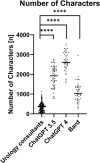Urology consultants versus large language models: Potentials and hazards for medical advice in urology
- PMID: 38751951
- PMCID: PMC11090772
- DOI: 10.1002/bco2.359
Urology consultants versus large language models: Potentials and hazards for medical advice in urology
Erratum in
-
Erratum.BJUI Compass. 2024 Dec 30;5(12):1324-1329. doi: 10.1002/bco2.482. eCollection 2024 Dec. BJUI Compass. 2024. PMID: 39744071 Free PMC article.
Abstract
Background: Current interest surrounding large language models (LLMs) will lead to an increase in their use for medical advice. Although LLMs offer huge potential, they also pose potential misinformation hazards.
Objective: This study evaluates three LLMs answering urology-themed clinical case-based questions by comparing the quality of answers to those provided by urology consultants.
Methods: Forty-five case-based questions were answered by consultants and LLMs (ChatGPT 3.5, ChatGPT 4, Bard). Answers were blindly rated using a six-step Likert scale by four consultants in the categories: 'medical adequacy', 'conciseness', 'coherence' and 'comprehensibility'. Possible misinformation hazards were identified; a modified Turing test was included, and the character count was matched.
Results: Higher ratings in every category were recorded for the consultants. LLMs' overall performance in language-focused categories (coherence and comprehensibility) was relatively high. Medical adequacy was significantly poorer compared with the consultants. Possible misinformation hazards were identified in 2.8% to 18.9% of answers generated by LLMs compared with <1% of consultant's answers. Poorer conciseness rates and a higher character count were provided by LLMs. Among individual LLMs, ChatGPT 4 performed best in medical accuracy (p < 0.0001) and coherence (p = 0.001), whereas Bard received the lowest scores. Generated responses were accurately associated with their source with 98% accuracy in LLMs and 99% with consultants.
Conclusions: The quality of consultant answers was superior to LLMs in all categories. High semantic scores for LLM answers were found; however, the lack of medical accuracy led to potential misinformation hazards from LLM 'consultations'. Further investigations are necessary for new generations.
Keywords: Bard; ChatGPT; artificial intelligence (AI); chatbots; digital health; global health; large language models (LLMs); low‐ and middle‐income countries (LMICs); telehealth; telemedicine; urology.
© 2024 The Authors. BJUI Compass published by John Wiley & Sons Ltd on behalf of BJU International Company.
Conflict of interest statement
No third‐party funding was utilized for the design of the study and collection, analysis and interpretation of data and in writing the manuscript. The authors declare no competing interests.
Figures


References
-
- Jungmann SM, Brand S, Kolb J, Witthöft M. Do Dr. Google and health apps have (comparable) side effects? An experimental study. Clin Psychol Sci. 2020;8(2):306–317. 10.1177/2167702619894904 - DOI
-
- Bommasani R, Hudson DA, Adeli E, Altman R, Arora S, von Arx S et al. On the opportunities and risks of foundation models. arXiv preprint arXiv:210807258. 2021.
-
- Grant N, Metz C. A New Chat Bot Is a ‘Code Red’ for Google's Search Business. The New York Times, 2023.
LinkOut - more resources
Full Text Sources
